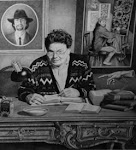The next subject Bishop broached in her 30 January 1961
letter is a sensitive matter, brought up to give Grace the context for why it
would prove difficult to have the Naudins visit Samambaia in the near future
(after all Bishop’s talk about wanting to host them there). Bishop could have
explained the situation briefly and left it at that, but she decided to give
her aunt the details, some of which I will not include in this post.
Before launching into the story, Bishop wrote, “we wish you
were here visiting us now.” One of the main reasons for this wish was
because “there is a baby in the house again.” Their “proper Bostonian friend,
Mary Morse, went and adopted one [a baby, that is].” Mary was the person Bishop
has supplanted in Lota’s heart, yet Morse lived nearby all along and had been
building a house “down below us.” This house was just “being finished,” though
it would not “be ready [yet] for another month, at least.” As a result, Mary
and the new baby were “living with us.” Whatever the complex relationship was
among these three women, proximity remained.
The long paragraph that followed this set up is a detailed
account of how 47-year-old Morse, “after talking about it for years,” finally
decided to adopt a child, something she had “been negotiating … for ages.”
Bishop explained to Grace that “the laws are like those in the US — you can’t adopt
legally until you’re over 50, unless you are married, and Mary is an old maid.”
The Brazilian feature film about Lota,
Elizabeth and Mary (“Flores Rares/Reaching for the Moon”) offers an interpretation of the
process of this adoption. Some of it fits with Bishop’s account in this letter,
some of it does not. Since this child, who was named “Mary Stearns Morse,” is
still living (indeed, my age), I am uncomfortable about including Bishop’s
account of her origins. Bishop told Grace that because of Mary’s age (under the
legal limit), “this baby was located through various intermediaries and no one
knew any one else’s name, etc.”
This film shows Lota (and Elizabeth, if I remember
correctly — it is some years since I saw the film) making the trip to pick up
the baby directly from the mother (who is portrayed quite differently from the person Bishop describes).
Bishop wrote that they did go “down to Rio to
see her for Mary, because we knew that even if the baby had four eyes
Mary wouldn’t be able to resist her.” But she noted that “a friend of ours” had
already picked up the baby and had her “checked out by one doctor.” When Lota
and Elizabeth took possession of her, they “took her to our doctor, for a final
check up.” All was well. Bishop declared her to be “a darling baby” between two
and three months old. Her direct description of this infant is curiously
expansive: “not pretty, but cunning; very bright, healthy, fat, and smiling,
poor little thing.” Their doctor declared: “She has the best things of all — good
temper,” because she hadn’t fussed when she was “prodded and poked” during
the examination; rather: “she laughed.”
Lota and Elizabeth “drove her back to Mary, in the pouring
rain, and announced ‘Here’s Monica’.”
(Mary Morse and Monica, 1961)
The next part gives an account of the baby’s mother and the
unfortunate circumstances that required her to “give away” such a “darling.”
Their Rio friend (the intermediary) “saw the
mother (we didn’t want to) and said she was absolutely broken hearted about
giving her up.” Bishop said it was obvious the infant “has been loved and well
taken care of.” One can only feel sad for this mother.
Bishop knew Grace would understand the sad circumstances
(akin to some of the situations she undoubtedly saw during her long nursing
career delivering babies) and would be interested in the nature and well being
of this little adoptee. Bishop reported that Monica “has been no trouble at all
— sleeps like an angel, eats like a horse, wakes up laughing, and only cries
when she’s wet or hungry.” She noted that this little person “act[ed] unhappy
and frightened for about ten minutes every day at six — isn’t it strange?”
Bishop had her own speculation as to why, based on the mother’s circumstances.
Finally, she declared Monica to be “a lucky child” because
“Mary will adore her and she will be moderately rich, and get a good education,
etc.”
I have omitted many of the more intimate details of this
account, but clearly Bishop wanted Grace to know about this important
development in their lives. She also told this story to her aunt because it
explained why it would be hard to have all the Naudins visit: “Mary is in one
of the two guest rooms and uses the extra bathroom for her and all the baby
things.” Having more company right then would have been too much.
The next post will bring this heady letter to a close and
hint at another, even bigger development unfolding in their lives in the first
days of 1961.







No comments:
Post a Comment